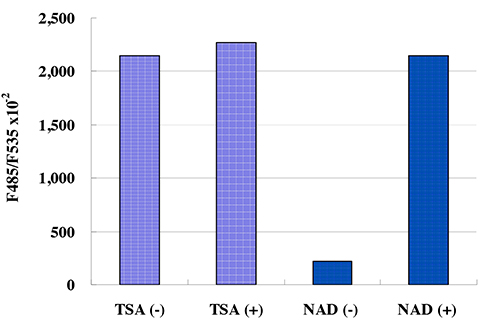CycLex® SIRT2 Deacetylase Fluorometric Assay Kit Ver.2
This kit is designed for the rapid and sensitive evaluation of SIRT2 inhibitors or activators using recombinant SIRT2 or purified SIRT2.
Target: SIRT2
Product Type: Kit
Application: ELISA
Research Area: Cancer, Immunology
Description/Background:
Sir2 is a conserved protein and was recently shown to regulate lifespan extension both in budding yeast and nematode. In 2000, it was reported that the yeast Sir2 protein is a NAD(+)-dependent histone deacetylase that plays a critical role in transcriptional silencing, genome stability and longevity. In mammals, the homologs of Sir2 have been named sirtuins (SIRT), with seven members in a family termed SIRT1 through SIRT7. They share a conserved central deacetylase domain but have different Nand C termini and display distinct subcellular localization, suggesting different biological functions (1).
In contrast to SIRT1, mammalian SIRT2 is localized mainly in the cytoplasm. SIRT2 colocalizes with the microtubule network and deacetylates Lys40 of alpha-tubulin (2). The same residue of alpha-tubulin is also deacetylated by HDAC6, a class II HDAC, and deacetylation by HDAC6 leads to changes in cellular motility (3).
A role for SIRT2 in cancer pathogenesis was demonstrated using a proteomic approach (4). The SIRT2 gene, which is located at chromosome 19q13.2, lies within a region that is frequently deleted in human gliomas, and levels of SIRT2 mRNA and protein expression are severely reduced in a large fraction of human glioma cell lines (4). Ectopic expression of SIRT2 in these cell lines suppressed colony formation and modified the microtubule network. These results indicate that SIRT2 may act as a tumor suppressor and may function to control the cell cycle by acetylation of alpha-tubulin. It was reported that SIRT2 inhibitor rescued alpha-synuclein toxicity and modified inclusion morphology in a cellular model of Parkinson’s disease, however the exact mechanism remains uncertain.
However, the conventional method for measuring SIRT2 activity is very complicated and laborious. In order to measure SIRT2 enzyme activity, it is necessary to prepare radioactive acetylated histone H4 as a substrate. First, cells have to be labeled metabolically with radioactivity by adding radioactive acetic acid to the culture medium. Second, radioactive acetylated histone has to be purified from the cells. Following the reaction, it is necessary to extract and separate the radioactive acetyl group, which has been released from acetylated histone, using ethyl acetate to measure the activity of the enzyme based on the radioactivity.
Although a method for measuring the activity of deacetylase without the use of radioactive substances was reported in recent years, owing to the use of fluorescent-labeled acetylated lysine as a substrate, the reaction product must be separated from the intact substrate and the fluorescent intensity measured by reverse phase HPLC. As mentioned above, these measurement systems are difficult to adapt for processing many samples under a variety of conditions, because of their complicated operation. Thus a simple system for biochemical analysis as well as for inhibitor screening without the use of radioactive substances is preferred.
Storage Temperature: -80°C
Protocols: ELISA
Regulatory Statement: For Research Use Only. Not for use in diagnostic procedures.
